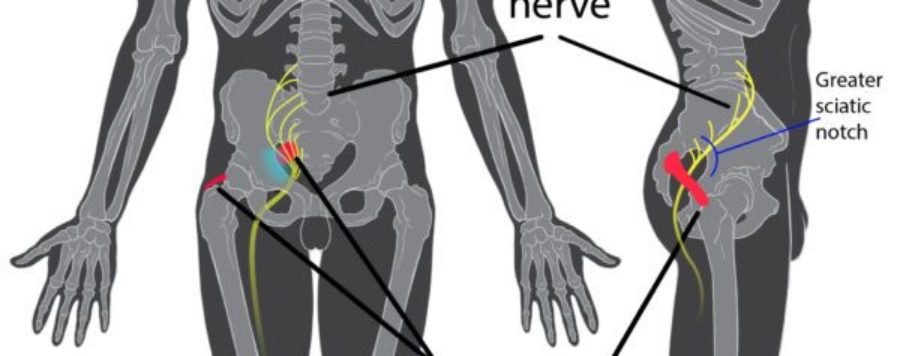The dreaded pain in the butt…
Do you have chronic butt pain? Don’t worry you are not the only one that suffers from this. It can not only become very annoying, but also very painful. Now there can be a large group of conditions that can contribute to this type of pain such as:
-Hamstring Injury
-Disc bulge or injury
-Spinal degeneration
-Sciatica
-Sacroiliac Joint dysfunction
-Facet Syndrome
Today, I will be discussing how one individual muscle could possibly be causing this chronic or re-occurring pain in the buttock region.
The word piriformis means “pear-shaped” in Latin. The piriformis muscle is a pear-shaped muscle that is located in the buttock region that sits deep to the gluteal muscles. It is one of six muscles that helps rotate the leg outwards. Mixed in with this group of muscles is the sciatic nerve, which runs from the low back all the way down the leg. The sciatic nerve runs behind, and sometimes directly through, the piriformis muscle. This is very important to remember when considering the cause for the patient’s discomfort.
Just like with other muscles in the body, if the piriformis muscle is injured, overused, or spasms patients will usually describe pain in the buttock area. The pain can stay localized, or if the muscle becomes tight enough it can pinch on the sciatic nerve. This results in an increase in pain, numbness, or tingling radiating down the back of the leg, calf, and foot.
Piriformis Syndrome vs. Sciatica: Are they the same or different?
Piriformis syndrome and sciatica do produce very similar symptoms, which can often lead to a misdiagnosis of one or the other. Even though the symptoms are very similar the root cause is very different. It is important to perform a proper analysis to determine which condition is present. As discussed above, piriformis syndrome relates to a muscle and the function of that muscle. Sciatica on the other hand, results from compression or impingement of nerve roots located in the lumbar spine area. This compression or impingement is usually secondary to spinal degeneration due to age or a herniated disc from trauma.
Understanding the biomechanics involved and using specific tests can help rule in or rule out the conditions present. Sciatica can be detected when a patient extends their leg outward while in a seated position with an increase in pain, numbness, tingling, and radiation down the leg. This motion places a stress on lumbar spine, increasing compression of the nerve roots that make up the sciatic nerve. If there is no increase in symptoms the patient should then lift their knee upwards toward their opposite shoulder. This motion tightens the piriformis muscle which could result in pain and sometimes compression of the sciatic nerve that runs behind it. If the increase in sciatica-like symptoms occurs, piriformis syndrome should be considered.
If you are having any symptoms such as pain, numbness, or tingling it is important to seek medical advice and confirm no other underlying conditions are present. Then discuss with the practitioner a plan of action to resolve your issues. Chiropractor’s specialize in the diagnosis and treatment of musculoskeletal conditions. The use of chiropractic adjustments and soft tissue mobilization can greatly benefit individuals suffering from symptoms of piriformis syndrome or sciatica.
By: Dr. Brennan Donahue


